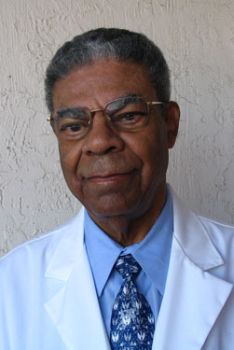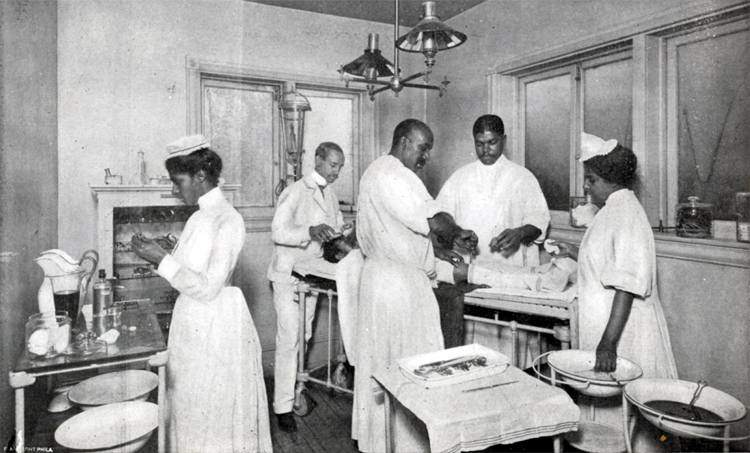
Kevin B. O'Reilly reported in American Medical News on 28 June 2008: "AMA apologizes for past inequality against black doctors." Black physician leaders welcome the apology but call for more efforts to diversify the physician work force and reduce racial health disparities.
The American Medical Association officially apologized in July for its history of excluding black physicians from membership, for listing black doctors as "colored" in its national physician directory for decades, and for failing to speak against federal funding of segregated hospitals and in favor of civil rights legislation.
"The AMA failed, across the span of a century, to live up to the high standards that define the noble profession of medicine," said AMA Immediate Past President Ron Davis, MD, in a commentary published in the July 16 Journal of the American Medical Association.

Dr. LeRoi Hicks, MD, MPH, Chief of Hospital Medicine
The apology came in response to an AMA-appointed expert panel's report on the historical racial divide in organized medicine, "African American Physicians and Organized Medicine, 1846-1968: Origins of a Racial Divide," also published in JAMA.
Former AMA President John C. Nelson, MD, MPH, personally apologized in 2005 for the Association's history of excluding black physicians, but the latest apology is an official statement of the AMA Board of Trustees.

Dr. Davis said the AMA is committed to increasing the number of minority physicians and improving its relationship with minority doctors. The AMA's Minority Affairs Consortium developed the Doctors Back to School program, which has sent physician volunteers to talk with more than 13,000 students from underrepresented groups about careers in medicine. Also, the AMA each year awards $10,000 scholarships to minority scholars -- more than $100,000 was awarded this year.
In a statement, National Medical Assn. President Nelson L. Adams, MD, commended the AMA for taking a "courageous step and coming to grips with a litany of discriminatory practices that have had a devastating effect on the health of African-Americans."

Dr. Adams urged the AMA to join the NMA in an effort to recruit more blacks into medicine, reduce racial health disparities and mandate cultural competency training as part of medical education and licensure. In 2004, the two organizations formed the Commission to End Health Care Disparities.
Randall W. Maxey, MD, PhD, the inaugural co-chair of the commission and a former NMA president, said the AMA's apology "opens the door to forward-looking cooperation" between the AMA and the NMA. Dr. Maxey, president of the Alliance of Minority Medical Assns., called for an annual summit meeting of high-level leaders of the AMA and the NMA. Dr. Davis called the proposal a "great idea."

In 1910, 2.5% of doctors and med students were black; in 2006, it was 2.2%
Anne C. Beal, MD, MPH, called the AMA's apology "an important first step." The matter is not "ancient history," because if it were, "we wouldn't be dealing with racial disparities in health care and health care outcomes. This is still something we're working with and dealing with today," said Dr. Beal, assistant vice president for the Program on Quality of Care for Underserved Populations at the Commonwealth Fund in New York City.

Lonnie Bristow, MD
Lonnie Bristow, MD, who became the AMA's first black president in 1995, said the apology "shows a mature perspective, and by comparison to the other institutions in our nation, including our government, the AMA is leading the way."
"That's what the AMA has always done," he said. "But it has also been a mirror reflecting American society."
The AMA's history of allowing discrimination goes back to its very beginnings, according to the panel's report. The Association's acknowledged founder, Nathan Smith Davis, MD, was crucial to the 1870 effort to exclude the integrated National Medical Society from admission to the AMA.
Four years later, the AMA adopted policy that effectively allowed each state to decide whether to let black physicians become members. Nearly all southern state medical societies barred black doctors from joining.

It wasn't until 1968 that the AMA threatened to expel organizations with racially exclusionary policies.
Robert Baker, PhD, lead author of the panel's report, said he was impressed that the AMA appointed an independent panel to examine its history and took the report seriously.
"They had no way of knowing what we would find and how we would parse it," said Baker, a bioethicist who served as a visiting scholar at the AMA in 2005. "There are very few institutions in American society willing to be that transparent and open about the past." (source: American Medical News)

Black doctors and the AMA: A timeline
- 1870: The integrated National Medical Society delegation is excluded from the AMA Annual Meeting in Washington, D.C.
- 1874: The AMA adopts a system of governance allowing state medical societies to determine which local societies will be recognized at AMA meetings, effectively allowing each state to decide the question of racial segregation.
- 1910: The AMA-requested Flexner Report, Medical Education in the United States and Canada, is published; the report recommends that all but two black medical schools be shut down.
- 1939: The AMA discontinues its policy of listing black physicians as "colored" in its American Medical Directory. The House of Delegates adopts policy discouraging racial discrimination in constituent society membership but allows it to continue.
- 1965-1968: The National Medical Assn. and the Medical Committee for Human Rights picket the AMA's meetings, protesting the Association's lack of action on state and county medical societies' racial exclusion policies.
- 1968: The AMA House of Delegates threatens to expel from the Association any state medical society that discriminates on the basis of race.
- 2004: The AMA and the NMA convene the Commission to End Health Care Disparities.


What a fantabulous blog this has been. . I am grateful to you and expect more number of blogs like this. Thank you very much.
ReplyDeletebest dental clinic sw edmonton
sw edmonton dentist near me
sw edmonton dentist
dental clinic sw edmonton
At this time advancements in is also affecting a point associated with argument. https://dynamichealthstaff.com/nursing-jobs-in-germany-for-indian-nurses
ReplyDelete